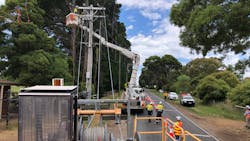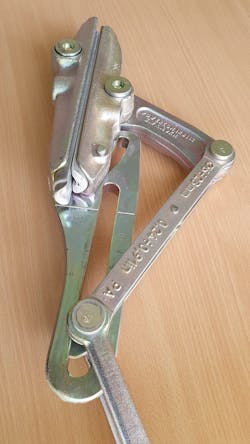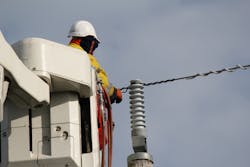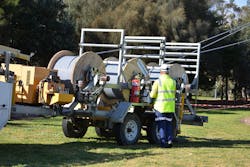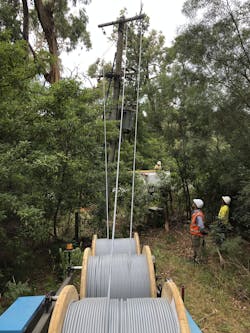United Energy in Australia Takes Action to Minimize Bushfire Risk
Southeastern Australia has a long history of devastating bushfires. More hot, dry and windy conditions as a result of climate change will create the ideal conditions for bushfires as sparks can easily ignite dry vegetation and be spread by the wind. Records confirm that the 2008- 2009 season remains the worst in terms of the number of fatalities, with the most serious fires being attributed to bare conductors creating earth faults resulting in the arc igniting the dry vegetation. Similarly, the 2019 -2020 fire season was particularly destructive in terms of fatalities and the desecration of wildlife, homes and businesses.
Prompted by the community trauma of the fires’ aftermath, the Victorian State Government launched a Royal Commission in 2009, which made recommendations covering the inspection of overhead lines, managing vegetation and the siting of homes and communities. They also recommended that electricity utilities adopted undergrounding or considered other technologies that greatly reduced the bushfire risk associated with overhead lines. There is evidence to suggest that energized bare conductors that fall to the ground creating earth faults can ignite vegetation. One such solution is insulated conductor technology otherwise known as covered conductors, which creates a barrier to protect against arcing from these electrical assets.
Therefore, with climate change making the risk of Australia’s bushfire seasons becoming longer and more intense, the Victorian distribution network operator, United Energy (UE) has deployed the use of lightweight covered overhead conductors in increasing lengths since 2017.
Practical challenges
Covered conductor technologies are far more cost effective than undergrounding as overhead lines extend over greater distances avoiding the installation barriers associated with installing underground cables, such as hitting hard rock or trenching through environmentally sensitive areas.
UE initially addressed this practical challenge with use of aerial bundled cables (ABC) on sections of their 22 kV and 11 kV distribution network. While this was an effective measure for reducing the fire risk, ABC is a relatively heavy cable. This meant it was difficult to install in long spans and often required upgrading pole top structures and the installation of additional poles. As a result, the use of ABC has been limited. It is also unsuitable for straightforward restringing and significantly more complex for constructing new, or upgrading existing bare conducted overhead lines.
A further challenge for UE’s network is that it covers an urban fringe to the east and southeast of Melbourne, including the Mornington Peninsula. These areas are characterized by heavy vegetation and tree growth, coastal bush, wineries and estates. Although, UE has a comprehensive vegetation management program, densely vegetated areas face an elevated risk of bushfires due to contact of bare overhead line conductors with the vegetation and the additional risk from sparks arising from conductor clashing.
Fire risk, reliability and cost savings
Following the Victorian State Government’s decision to provide funding for the research and development of an alternative to bare overhead line conductors, Ground line Engineering, an Australian engineering consultancy, invited UE to collaborate and share the significant cost of a development project. UE accepted this opportunity to partner with Groundline Engineering to develop a mature covered overhead line conductor system to satisfy the operating environment in Victoria.
As a starting point, agreement was reached on the required performance criteria for covered overhead line conductors. Groundline Engineering led research into alternative covered conductor technologies and the technical standards used around the world. The solution required a covered overhead line conductor able to withstand summer temperatures of up to 45 ˚C, winter temperatures as low as -5˚C and very high exposure to ultra-violet (UV) radiation from spring to autumn. The product also needed to withstand salt spray in coastal areas and pollutants in cities. A further requirement was the ability to withstand severe wind-induced vibrations that can occur in coastal areas on overhead lines having long spans and high tensions.
An important condition of the funding was the development of solutions for the standard three-phase distribution network, as well as for single-wire earth return (SWER) overhead lines. The latter are predominantly used for the long distribution lines installed to supply the Australian population resident in remote rural areas. Some 200,000 km (124,300 miles) of SWER overhead lines are used to provide cost-effective energy supplies to these remote communities and they are often erected through high fire-risk areas. Although, UE only has 43 km (26.7 miles) of SWER lines, it was still regarded as an important priority for the project.
The research led to Europe where the covered overhead line conductor market is mature, particularly in the Nordic countries. They are densely forested and like Australia they have a low population density. Covered overhead line conductors have been used there for decades to protect against winter snow, wind and ice conditions to limit the contact with tree branches and wildlife. It has also been deployed in the Middle East in coastal desert locations where power lines need to withstand corrosion caused by sea-salt air, erosion from sand and high UV.
In these environments, the technology has been found to withstand extended contact with vegetation and the ground over months without experiencing burn-through.
Three layers of covering
The covered overhead line conductor specification chosen by UE has three layers of covering. A semi-conductive inner layer provides good electrical field stress control, a high-grade electrical insulation in the middle gives electrical performance and a tough outer polymer jacket provides the mechanical protection. This outer layer needs to be particularly tough to withstand mechanical abrasion, as well as intense UV light.
It is a fully sealed system that prevents water ingress and meets the European Standard EN 50397-1-2006 for covered overhead line conductors. An important feature is that the design life of covered conductors is 40 years, which is comparable tobare conductors.
Mix of standard and specially developed products
The UE project team selected three covered overhead line conductors with cross-sectional- areas that could be used to fulfil all the needs of the distribution network. The object was to use the largest conductor as a direct replacement for all aluminum conductor (AAC) lines installed on the three-phase distribution networks serving urban, semi-urban and rural areas.
For this application the selected covered conductor was an all-aluminum alloy conductor (AAAC) having a cross-sectional-area of 159 mm2(0.246 in2).To replace the mid-sized AAC and aluminum conductor steel reinforced (ACSR) overhead lines the selected covered conductor was an ACSR having a cross-sectional-area of 62 mm2(0/096 in2).
A smaller size covered overhead line conductor was required for Australia’s rural and remote areas (primarily SWER network), which are often served by smaller HV conductors including galvanized steel. A standard product was not available for this application, so the Swedish cable manufacturer Amokabel developed a new product specially for the project, namely, an aluminum clad steel conductor with a cross-sectional area of 25 mm2(0.038 in2).
As a result, Amokabel remain the sole manufacturer of all the covered conductors used by UE based on their ability to meet UE’s specifications, experience and ongoing technical support.
Laboratory testing
The project partner Groundline Engineering was responsible for conducting an extensive program of laboratory testing of the selected covered conductors at the Swinburne University of Technology in Melbourne against Australian and international standards.This program included:
- electrical testing for voltage, current, resistance, current leakage, surge and lightning strikes.
- mechanical testing of tension, vibration, water penetration, thermal testing and abrasion testing.
- exposure to UV, flame and radiant heat and mechanical abrasion tests from tree species that are native to Southeast Australia.
The selected covered overhead line conductors satisfied or exceeded all the applicable standards requirements.
Initial field trials
Encouraged by the covered overhead line conductor’s performance during testing and the collective overseas operational experience from a wide range of climates, UE decided to progress with field trials. These were particularly important as Australia has unique environmental conditions.
For example, Australian trees have very high hardness levels to the extent that the country has its own rating scheme for measuring timber hardness. Known as the ‘Janka hardness rating’, it ranks European trees at 4, whereas some native species in Australia are rated at 10.
UE selected two sites for the field trials focusing on one SWER overhead line and one three-phase overhead line. They wanted to select sites that would provide the right level of challenge to give the product a fair evaluation, given the environmental features of geography, line design, span length and pollution levels. Accessibility was another important consideration as it was also essential for crews to be able to visit the sites regularly for routine inspections.
The SWER trial site - UEidentified an existing overhead line in the suburb of Cape Schanck. It is erected in a high bushfire risk area and is routed along the coast, so it also offered the ability to prove the covered conductor’s ability to withstand a corrosive coastal route environment.
The three-phase line trial - UE selected an existing overhead line in the town of Mordialloc. This circuit required much larger and heavier overhead line conductors required to supply larger loads and withstand higher fault currents. The utility had experienced some non-bushfire related reliability issues and outages in this area, for example, conductor clashing. It was therefore important to determine whether the new covered conductors would resolve these issues.
Throughout the two trials, staff from Amokabel familiar and experienced in the handling and stringing of covered overhead line conductors were available on site to assist the linesmen employed by the overhead line contractors.
Overhead Line Tooling
Covered overhead line conductors require special tooling and installation techniques completely different to those used with bare conductors as it is important to avoid damaging the conductor’s sheath by using incorrect tools or over tensioning.
Also, their overhead line contractors had to receive on-site training and familiarization in the handling and stringing of covered conductors to the appropriate tension. The contractors proved to be excellent accepting the new product and adapting their work practices and also, in providing feedback that conductor stringing was very similar to installing the bare conductors.
The use of ‘come-along’ tools specially designed to grip the covered conductor and string it to the require tension without causing damage to the conductor’s outer sheath proved to help in minimizing the tooling costs.
Product acceptance and deployment
The two field trial sites were completed in 2017 and have been in fault-free operation ever since. UE undertook six-monthly inspections for the first eighteen months at both sites, and there has been no evidence of conductor clashing and network reliability issues at the Mordialloc site.
As a result of the success of testing and field trials, UE integrated the use and installation of covered overhead line conductor technology into their overhead line standards. They now have a targeted program of replacement in place that focusses on those areas that are classified by the State Government as being heavily vegetated imposing a high bushfire risk.
Future prospects
Following the success and performance of the trial sites at Mordialloc and Cape Schanck, UE has completed a number of additional installations. The use of covered overhead line conductors has helped UE to manage the bushfire risk by providing a cost-effective retrofit solution for overhead line upgrades plus the potential to boost network reliability.
Furthermore, UE as the first distribution utility in Victoria to trial the use of Amokabel covered overhead line conductors they have given technical advice to other utilities in Victoria sharing its experience with the tooling and the training of field crews.
To date, UE and the other distribution utilities in Victoria have erected 150 km(93miles) of covered conductors on overhead lines as this technology now seemingly offers the opportunity for a wider roll out, especially for the high bushfire risk areas in Victoria and elsewhere in Australia.
About the Author
Dimitrios Tsirikis
Dimitrios Tsirikis is the principal engineer distribution at United Energy.
